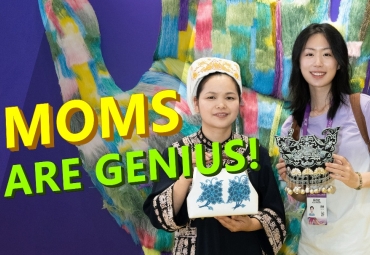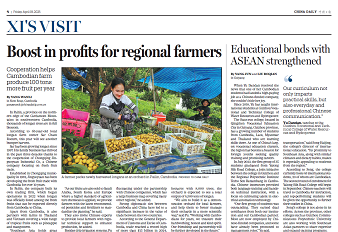Stitch by stitch, Miao embroidery wins new fans

Zhao Naihua (middle) and four Miao ethnic embroiderers display their work. CHINA DAILY
A Spanish-Chinese businessman is promoting Miao embroidery abroad, boosting the income of women in Guizhou province and promoting their traditional art internationally. Earlier this year, Zhao Naihua watched as Miao women worked on embroidery in Guizhou's Houshan township for the first time, and was touched by the beauty of the traditional art.
The 52-year-old then attempted to make a piece himself, to get a better feel for the process.
While he enjoyed the experience, which allowed him to appreciate firsthand the depth of traditional culture, it also helped him understand the plight of the women who rely on embroidery to make a living.
"Miao embroidery depicts the love of life and can last for many years," Zhao said, adding that in the past, he knew the pieces were beautiful, but didn't know much about the stories behind them.
The Miao woman who taught Zhao had been diagnosed with breast cancer three years ago and was told by doctors at the time that she had less than a year to live. She told Zhao that at first, she broke down, but when she picked up her needles and threads, they helped calm her down. Gradually, she learned to make peace with her condition and continues to embroider as she fights her illness, paying for her medical bills with her embroidery.
The woman's story moved Zhao deeply.
Houshan township, which is located in northern Guizhou, is home to about 10,000 people, 40 percent of whom are Miao. Girls from the ethnic group begin to learn embroidery at a young age, and most Miao women in the township know how to weave, dye and embroider.
"A machine-embroidered Miao outfit only costs about 200 yuan ($30), but one embroidered by hand costs more than 6,000 yuan. Some even cost as much as 8,000 yuan," said Li Zhaofen, a Miao resident of Houshan who relies on her embroidery to make a living.
"Despite being promoted and boosted by the local government, the market for embroidery is not fully developed, and the women only make enough to get by. If we want to ensure this intangible cultural heritage is passed on and improve sales, the market has to be opened further," Li added.
Originally from Shaoxing in Zhejiang province, Zhao settled in Spain in 2005 and now serves as the vice-president of the China Association of Investment and Commerce in Madrid. He plans to use his connections to introduce Miao embroidery to overseas markets and help the women earn more money.
After returning to Spain, Zhao organized an exhibition to showcase the embroidery, including clothing and accessories. It was a great success. "Chinese embroidery work is amazing and so beautiful. I get a deeper appreciation of this art by wearing it," said Madrid resident Juan Manuel Ojeda, who visited the exhibition.
As China's textiles and fabrics are popular internationally, and Miao embroidery is appreciated by many foreigners for its charm, Zhao saw potential in the market.
He returned to Houshan and set up a workshop in cooperation with the local government and embroiderers. It sells their works to overseas customers, boosting the local economy and helping people make a better living.
To blend fashion and traditional art, Zhao has connected designers in Mexico and Spain with embroiderers in Guizhou, who collaborate on creations online. "We've done fairly well. In less than seven months, sales have amounted to about 200,000 yuan, and that's helped 30 women raise their incomes," he said.
Li said: "My pieces have been sold overseas thanks to good policies and Mr Zhao's help. Now I have a stable monthly income, and I am very happy."
Next, Zhao will work with associated government departments to train more embroiderers to encourage more people to get involved in keeping the art alive.
"The traditional techniques have been properly passed on, but innovation is needed," Zhao said, adding that the workshop will continue to help the women produce innovative pieces to promote their work abroad.
Zhao Yandi contributed to this story.
All rights Reserved. 京ICP备13028878号-8







 Overview
Overview Guiyang
Guiyang Guian New Area
Guian New Area Liupanshui
Liupanshui Anshun
Anshun Qianxinan
Qianxinan Qiandongnan
Qiandongnan Qiannan
Qiannan Zunyi
Zunyi Tongren
Tongren Bijie
Bijie Guizhou commits to culture preservation and rural vitalization
Guizhou commits to culture preservation and rural vitalization Guizhou voice at 2025 national two sessions
Guizhou voice at 2025 national two sessions Meet the 'genius moms' at Shenzhen cultural fair
Meet the 'genius moms' at Shenzhen cultural fair 

